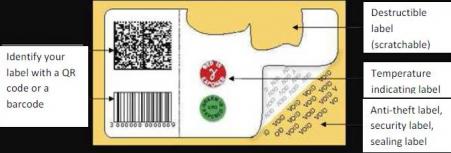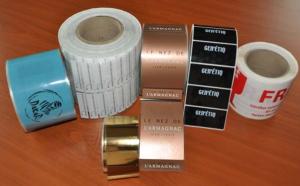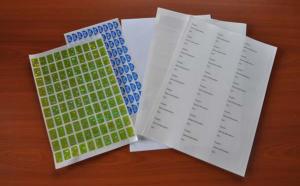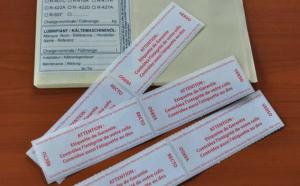Smart labels
Let intelligence into your label

Examples of technologies making your Label smart
A label is certainly a constraint, but when it is made intelligent, it turns into an asset.
A smart label can have several functions. It can be used to authenticate, to secure, to identify and to trace your product. We can provide labels that carry guarantee warnings, labels with open or tamper evidence, labels with temperature or sterilisation indicator. For example, a sterilisation indicating label will tell if autoclaved equipment has been sterilised or not.
Building your label, adhesive sticker
We develop our know-how to meet the requirements of our customer's project and we control all the technologies necessary to make their Label unique in order to suit their needs.
Materials
Among others, the material of the labels can be made from the following:
Polyethylene (PE): A synthetic and flexible material that offers good resistance to UV and ambient weather conditions, but does not resist heat. Its flexibility allows the use of flexible packaging.
Polypropylene (PP): A synthetic and semi-flexible material with very good resistance to UV, ambient weather conditions, solvents and heat. It is more rigid and less sharable than PE, and therefore suitable for more constraint-demanding applications.
Polyester (PET): Extremely resistant and relatively tough, PET provides very good resistance to UV, solvents, low and high temperatures, therefore suitable for harshcondition applications.
Paper (vellum): could be matte, glossy, thin, thick (55grs toilet paper, geographical maps 72 grs)
Adhesives
Temporary (removable or repositionable) adhesives: A Label coated with an adhesive that has a final low adhesion force can be removed from the substrate and repositioned shortly after.
Permanent Adhesive: As it suggests, permanent adhesive will readily fix permanently on substrates. It is not intended to be removed.
Reinforced adhesive: It is one used on harder surfaces such as steel, wood etc. It is resistant to solvents.
Printings
Flat: The Label is completely printed in one colour.
Gilding: A hot-printing technology where heated die is used to lay gold leaves or metallic pigments on a substrate.
Hologram: A printed device inserted in or laid on valued objects such as credit cards, tickets, passports, software boxes and other items in order to reduce reproducibility.
Their characteristics are difficult to replicate by counterfeiters.
Scratch-off mask: A customized over-coat (of colours and patterns) on "pin" destined to hide information or numbering that will reappear after scratching the area with a sharp edge.
Varnish: An additional layer of print to either gloss or matte finish a label.
VOID: A method or device used primarily on security labels to seal product or package. When the label is removed, the VOID is set-off and a message appears confirming violation.
- The Label is said to be a VOID label or simply VOID evident when the removed Label transfers partially or totally both on the label and the product.
- The Label is said to be VOID non-transfer when the removed Label leaves no transfer on the product.
Thermochromic ink: ink used to induce reaction to temperature changes in Labels.
Individually customised Label: By thermal transfer printing, a Label may be customised using pin-code, bar code, an alphanumerical code, algorithm, invisible tracer, a logo, an image, a selected text, in one or more colours.
Photochromic: Label tint will vary in function of the ambient light intensity
Fragrant ink: Label that will diffuse a fragrance when it rubbed
Phosphorescent: Label that will illuminate in darkness
Fluorescent: Label that will illuminate under light
UV-visible: Security Label will show a message, a cryptogram under a UV lamp
Glitter printing: Label will glitter strass and sequins
Coating
Coating is applied on some product lines. It increases the life-span of a Label and also adds value to the product by its tint thereafter.
The coating can either be glossy or matte.
- The glossy coating enhances colours, making them more vivid and emphasis contrasts.
- The matt coating, presently trendy, gives the label a soft satiny touch, a sober and elegant distinction.
The cut
Labels are cut with dies positioned on the machine cylinder. The cut can be through-cut (front-to-back) or half-cut (cut to glue).
During manufacturing, the half-cut isolates the Label on the silicone substrate. The edges are then removed by weeding. The weeded Label is the standard Label per say.
When Labels are customised, the weeds serve as references to position them and thus to stall for printing.
The continuous cutting: Label is not cut, the substrate being a continuous strip. One side of it is ripped, so as to easily detach it.
The spot: if the Label or the release liner is transparent, a thermal transfer printer will be unable to detect weeds. Therefore, it is necessary to print black spots on the back to allow the printer detect the position of the Label and to stall for printing.
Cuts: we effect all possible shapes of cuts. Every one requires a specific tool.
Pre-cut: can be between Labels to facilitate detaching one from another or inside the Label itself to put it apart.
Packaging
Packing is done to your specifications.

On reels

In sheets

In singles

In accordion
See also :
